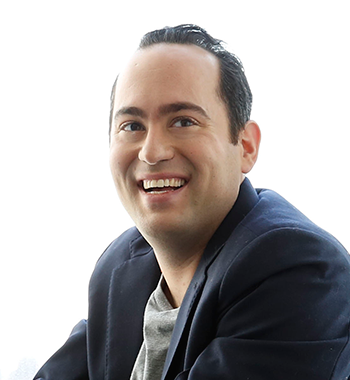There's a photo of me from my high school prom from 1994. I'm wearing the traditional tux, paired with bug-eyed Bono-style sunglasses, muttonchops and a bushy goatee. And if you could see my lower half, there'd be a chain wallet and pair of Airwalks.

Eric Gillin, Epicurious.com Elizabeth Lippmann
At the time, I'm sure I was the height of fashion. Twenty-two years later, all I can see is an unfocused grab bag of whatever trends were popular and a blind hubris that I was totally about to slay prom. (I did not slay prom.)
The internet is that awkward, embarrassing teenager. The chronology kinda matches. While the internet was invented by Tim Berners Lee 27 years ago, it didn't reach more than a third of the U.S. population until 1999, making it about 17 years old. (Fun fact: Epicurious turns 21 in August. Drinks on us!)
So, what are we to make of our teenage internet?
Like many teenagers, the internet thinks it's cool, but—real talk—it's still awkward and annoying. Pages still aren't mobile-optimized, they take forever to load and they tend to look the same. This is a world that remains dominated by right rails with box ads, skinny content wells and recirculation units at the bottom of pages. And when the internet looks different, when the ads and pictures and words get bigger, it's usually a special occasion. Offsite, content is stuffed into feeds, usually Facebook or Google, where it all pretty much looks the same: clickbait clamoring for attention, like teenagers at the prom.
Makes me a bit heartsick for the early days.
When the internet was a baby, everything it did was amazing and perfect and a tiny little miracle. We didn't even notice how annoying it was to watch an image come in, one line at a time, bit by bit, over a dial-up connection. We didn't care that most of the internet looked like the Drudge Report and that the primary way to navigate was to "surf"—clicking links at random just to see what happened. Google? How was that company going to be the best at search—we had AltaVista!
We were so naive. And while we think our internet is all grown up, we're still naive. Immature. Look at the basic business model that dominates digital media. Content producers have to amass as many eyeballs as possible to generate as many ad impressions as they can. Then they sell these impressions by a metric ton. Targeting, retargeting, fancy creative, viewability and programmatic help with ROI, but at the end of the day we're all living off crude math: More impressions = YASSS!
This never-ending pursuit of attention, the "need for more," is why slideshows exist, why people are livestreaming fruit wrapped in rubber bands, and why top-down videos of frozen Doritos-flavored margarita taco shots have suddenly taken over the internet. Luckily, it won't last forever.
Adulthood beckons. The pressure is mounting. Real-world constraints are being placed on the internet. Whether that be users deploying ad blockers to get away from the clutter, advertisers requiring viewable ads, Facebook penalizing spammy content, or Google pushing for mobile-optimized sites—we're seeing demand rising for quality audiences, quality revenue, quality experiences and quality content.
But right now, that's not necessarily a profitable path. You don't make any more money from a loyal user who loves you as you do from a random stranger who clicks accidentally. You don't make more money from selling one big, beautifully placed digital ad than you do selling five standard units. You don't make more money from making an awesome product—it's easier to make money by producing content that appeals to the lowest common denominator and stuffing it into a product that's designed for what the business wants, not what the user wants.
And this is why the Internet still has sideburns and MC Hammer pantaloons in a drawer.
For digital brands to be able to evolve, we need to find a way to increase the value of the deeper connection over the broader one. As Josh Topolsky pointed out on Medium and Jim VandeHei said in The Information, this move to quality has to continue or we'll never reach adulthood.
Brands that will thrive as adults will be those that were raised well. They have actual values and integrity—The New York Times, Vox Media and The New Yorker come to mind. These brands have clearly defined missions, not just clearly defined growth targets. They talk to specific audiences, even if it means they won't reach the widest audience. And they form deep, lasting connections that enable them to create happy digital subscribers, more pleasing ad units that engage users and one-of-a-kind content experiences that redefine digital.
And as the "parent" of a brand, I hope that Epicurious is doing it well by staying true to our mission—to help home cooks. In 1995, this meant inventing a recipe database. Today, it means redesigning our recipe search so it's more shoppable—not just an empty field with a blinking cursor—and trying to thoughtfully integrate ads. Tomorrow, it might mean infusing a one-time recipe algorithm into your wearable cooking prosthesis.
Are we perfect? No. We're subject to the same macro trends that govern these awkward teenage years. We have right rails, banners and our share of blinking boxes. But we're also accountable to our users and advertisers and have to put out the highest quality product we can. Because the day the bug-eye glasses and goatees go away, it'll be about the quality of the attention we receive, not just the quantity of attention we get.
And when that day comes, I'll look back and wince.
Eric Gillin is executive director of Condé Nast's Epicurious.com and head of product for the Food Innovation Group. His Twitter handle is @ericgillin.








